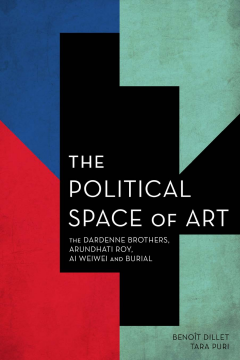
Additional Information
Book Details
Abstract
This book studies the tension between arts and politics in four contemporary artists from different countries, working with different media. The film directors Luc and Jean-Pierre Dardenne film parts of their natal city to refer to specific political problems in interpersonal relations. The novelist Arundhati Roy uses her poetic language to make room for people’s desires; her fiction is utterly political and her political essays make place for the role of narratives and poetic language. Ai Weiwei uses references to Chinese history to give consistency to its ‘economic miracle’. Finally, Burial’s electronic music is firmly rooted in a living, breathing London; built to create a sound that is entirely new, and yet hauntingly familiar.
These artists create in their own way a space for politics in their works and their oeuvre but their singularity comes together as a desire to reconstruct the political space within art from its ruins. These ruins were brought by the disenchantment of 1970s: the end of art, postmodernism, and the rise of design, marketing and communication. Each artwork bears the mark of the resistance against the depoliticisation of society and the arts, at once rejecting cynicism and idealism, referring to themes and political concepts that are larger than their own domain. This book focuses on these productive tensions.
Overall, this book offers a stimulating examination of the relationship between art and politics through the theoretical lens of the philosophy of art in an innovative way. The authors provide a rich set of references to different authors such as Blanchot, Deleuze, Stiegler, among others. […] [T]he value of this book is not limited to its selection of artists, but also to its focus on the political space of art and materiality. This gets rid of the traditional distinction between art, politics and the world, bringing forth a more powerful critique of our time by moving beyond the analysis of meaning or artistic merit into how art works. Although the analysis of the materiality of art fits remarkably well with the artworks examined, it might also be useful for the study of other artists, not as a method, but as a reminder of the physical space of art and its connections to the world.
Using four artists working in different art forms – filmmakers The Dardenne Brothers, writer Arundhati Roy, visual artist Ai Weiwei and musician Burial – the book explores the formation of creative work within a thick web of political relationships and spheres … Unlike most books about art, usually written from an art or art historical perspective, this publication is written from a political/philosophical standpoint. Dillet and Puri analogise in the introduction that, just as Deleuze and Guattari argue for a non-philosophical approach to philosophy to see the different facets of how it really operates, a “non-art approach to art” is required to open up insights into its effect.
This is a novel and original work of political theory by two exciting and emerging scholars in the field.
Robert Porter, Director of the Centre for Media Research, Ulster University
Benoît Dillet is an Assistant Lecturer in Political Thought at the School of Politics and International Relations, University of Kent.
Tara Puri is a Global Research Fellow at the Institute of Advanced Study, University of Warwick.
Table of Contents
| Section Title | Page | Action | Price |
|---|---|---|---|
| The Political Space Of\rArt | Cover | ||
| Contents | v | ||
| List of Figures | vii | ||
| Acknowledgments | ix | ||
| Introduction | 1 | ||
| The Political Gesture | 3 | ||
| Encroachments | 5 | ||
| The Road Map | 7 | ||
| 1 Aesthetics, Poetics and Techno-Aesthetics | 13 | ||
| From Aesthetics to Poetics | 15 | ||
| For a Critique of Techno-Aesthetics | 18 | ||
| 2 Left-over Spaces: The Cinema of the Dardenne Brothers | 29 | ||
| Broken Cities | 29 | ||
| Woods | 36 | ||
| Motorways | 38 | ||
| What Is a Left-over Space? | 40 | ||
| 3 Arundhati Roy’s Language of Politics | 47 | ||
| The Hyphenated Writer | 47 | ||
| The Cracks of a Generation | 52 | ||
| Naming into Existence | 56 | ||
| Bearing Witness | 61 | ||
| 4 Ai Weiwei’s Useless Materials | 67 | ||
| The Weight of a World | 67 | ||
| Forging Time | 73 | ||
| Living Under the Lengthening Shadows | 76 | ||
| Material Qualities | 80 | ||
| 5 Burial’s Muffled Soundscape of London | 87 | ||
| Prelude to the Rave | 87 | ||
| In the Headphones-Ear Interstice | 89 | ||
| Departing from Nostalgia and Hauntology | 92 | ||
| Metallic Sound | 94 | ||
| Untrackable Tracks | 96 | ||
| After Untrue, In Search of the New | 98 | ||
| Hardcore Continuum Redux | 103 | ||
| Becoming ‘The Name of a Tune’ and the Underground Condition | 104 | ||
| Conclusion | 111 | ||
| Bibliography | 115 | ||
| Index | 125 |
